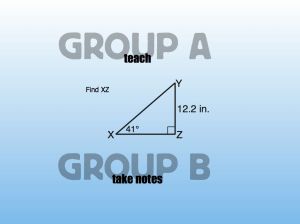The Description:
This is a math adaption of the World Cafe, which according to its website is “a powerful social technology for engaging people in coverasations that matter”. I recommend reading their website for a complete description. The World Cafe also has an extensive online community that can be found here. I have authored several posts about my experiences implementing it in a math class, which can be found there. As far as I know, I am the only person implementing this in a math class.
For the World Cafe you put desks in groups of four, and cover the desks with butcher paper, which I call the table cloth. The butcher paper is like their scratch paper, and they should be doing all the problems on it. Once they have finished working on the problem, they discuss with eachother about what answer is correct. Once they have decided on a correct answer, they must write it, along with all the steps, onto their World Cafe Menu.
Each problem is one round, and at the end of each round, all students must get up and go to a different table. They are not allowed to follow the same people table to table, they must randomly disperse.
At the beginning of each round I give them a minute or so to introduce themselves to their new group, and I make them write their group members names on their menu.
The Advice:
– The actual World Cafe has a table host, but I do not use a host in my classes.
– Make sure that the students write the names of each of there group members in their own writing – passing the menu around for others to sign is not allowed.
– I give the students a two minute warning by playing my harmonica. And then I play it again when it’s time to switch seats. Maybe you can use music or something if you don’t play an instrument.
– Students should be allowed to doodle on the butcher paper.
– When you don’t give students colored markers, they tend to doodle less and they do more math. So I don’t they them colored markers.
– Only final draft work hits the menu, and only right answers get credit. I tell the students that I do not want to see eraser marks on the menu, that should all be done on the butcher paper. Telling them I only accept correct answers provides motivation for them to figure out each problem.
– I through in extra credit for my favorite menus. I have students take them home and turn them in the next day.
The Goods:











